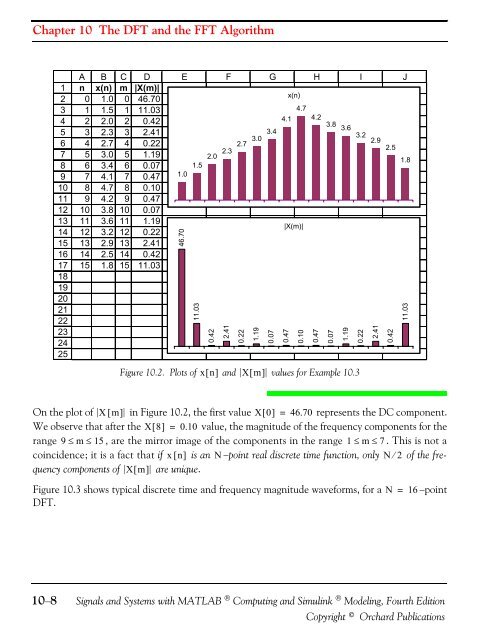endof-
Signals & Systems Front Cover FOURTH.qxp - Orchard Publications
Signals & Systems Front Cover FOURTH.qxp - Orchard Publications
You also want an ePaper? Increase the reach of your titles
YUMPU automatically turns print PDFs into web optimized ePapers that Google loves.
Chapter 10 The DFT and the FFT Algorithm12345678910111213141516171819202122232425A B C D E F G H I Jn x(n) m |X(m)|0 1.0 0 46.70x(n)1 1.5 1 11.034.72 2.0 2 0.424.1 4.23 2.3 3 2.413.44 2.7 4 0.225 3.0 5 1.192.0 2.3 2.7 3.0 3.8 3.63.2 2.92.56 3.4 6 0.07 1.57 4.1 7 0.471.08 4.7 8 0.109 4.2 9 0.4710 3.8 10 0.0711 3.6 11 1.1912 3.2 12 0.22|X(m)|13 2.9 13 2.4114 2.5 14 0.4215 1.8 15 11.0346.7011.030.422.410.221.190.070.470.100.470.071.190.222.410.421.811.03Figure 10.2. Plots of xn [ ] and Xm [ ] values for Example 10.3On the plot of X[ m] in Figure 10.2, the first value X0 [ ] = 46.70 represents the DC component.We observe that after the X8 [ ] = 0.10 value, the magnitude of the frequency components for therange 9≤ m≤ 15, are the mirror image of the components in the range 1 ≤ m≤7. This is not acoincidence; it is a fact that if x[ n] is an N−point real discrete time function, only N ⁄ 2 of the frequencycomponents of Xm [ ] are unique.Figure 10.3 shows typical discrete time and frequency magnitude waveforms, for aDFT.N = 16−point10−8Signals and Systems with MATLAB ® Computing and Simulink ® Modeling, Fourth EditionCopyright © Orchard Publications







